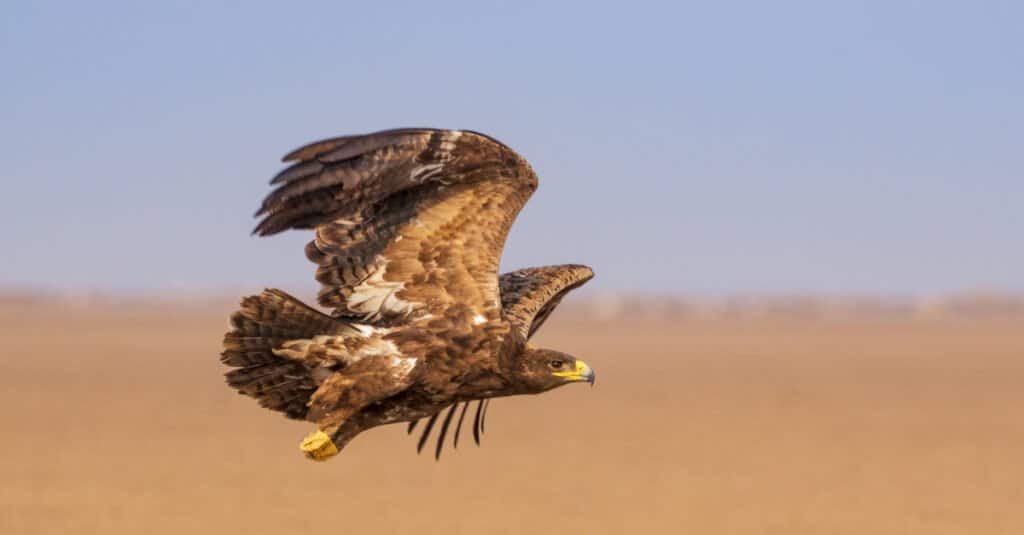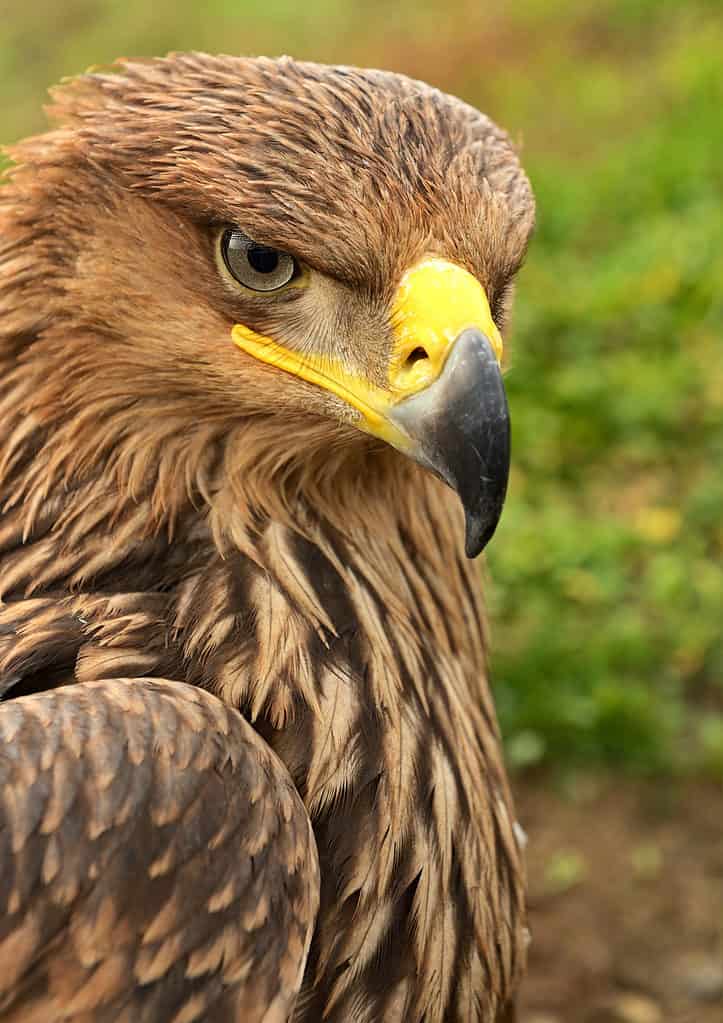Egypt is a Middle Eastern country on the Mediterranean and the Red Sea. The famous Nile River flows through the country emptying into the Mediterranean. The Nile divides the two desert regions of the Eastern Desert (Arabian) and the Western Desert (Libyan) with around 95% of the country covered in this arid desert habitat. The Nile River provides an ecosystem for a wide variety of wildlife but much of the country is limited to animals that can survive in some of the harshest dry conditions. When it comes to birds there are a variety of shorebirds and migratory birds that can be found along the coast and around Lake Nasser, the largest lake in Egypt. But the bird that was chosen as the national bird has its origin dating back thousands of years. Read on to find out all about the steppe eagle, the national bird of Egypt!
What is the National Bird of Egypt?
The national bird of Egypt is the steppe eagle. The eagle has been an important symbol in Egyptian history dating back to the Pharaonic era, 3000 B.C. to 323 B.C. Eagles were a common symbol on Egyptian temples and were the prized bird of the first Sultan of Egypt, Saladin. Therefore, it is often referred to as the Saladin Eagle.

The steppe eagle is the national bird of Egypt with a wingspan of approximately 5.5-6 feet.
©Hardik Shelat/Shutterstock.com
What is a Steppe Eagle?
A steppe eagle is a large bird of prey that, like other eagles, has strong talons and a hooked beak. Steppe eagles are varied shades of brown with darker wingtips. The wingtips also feature seven individual feathers that look like fingers in flight. They have a yellow marking behind their black beak and matching yellow legs and talons.
What makes steppe eagles different than most eagles is they nest on the ground. They also mostly hunt on the ground, watching with their keen eyes for ground squirrels and other small mammals. Therefore, this is how they get their name “steppe” eagle with a steppe habitat being plains of grassland usually with few or no trees.
How Big are Steppe Eagles?
Steppe eagles can get to be almost 3 feet tall, with an average length between 24-35 inches. The wingspan of the steppe eagle is usually between 5 ½ -6 feet but gets to 7 feet or more. The males are smaller than the females with females weighing between 5-10 pounds and males weighing 5 ½ -7 ½ pounds. Compared to other eagles they are considered medium-sized eagles. American bald eagles, for example, have a wingspan of 8.2 feet and weigh around 17 pounds.
Is the National Bird of Egypt on the Egyptian Flag?
Yes. The Egyptian flag has an eagle featured in the center of the flag. Some refer to it as the “Egyptian eagle of Saladin” and the image is always in gold. The flag itself has three equal horizontal stripes of red, white, and black. During the 1952 Egyptian Revolution, the tricolor flag was used with the red representing the bloodshed, the white representing the purity of the hearts of the Egyptian people, and the white stripe above the black stripe representing the light overcoming the darkness.

The flag of Egypt showcases the steppe eagle in the middle surrounded by colors that symbolize bloodshed, purity, and light over darkness.
©iStock.com/Anton Litvintsev
Is the National Bird Featured on the Egyptian Money?
The national bird of Egypt is featured on the 25 PT banknote of the Egyptian pound. The back of the banknote has the Egyptian coat of arms which is a large eagle with a tricolor shield in the center. The eagle is holding a scroll that reads “Arab Republic of Egypt” in Arabic. The front of the banknotes all feature prominent mosques in the country and the backs have a variety of Ancient Egyptian motifs like The Great Sphinx of Giza and a Pharaonic war chariot. The coins include Tutankhamun (King Tut), Cleopatra, the three pyramids of Giza, and several mosques.
What other Animals are Symbolic in Egypt?
Many animals have been displayed in tomb scenes or carved into pyramids. Mummified cats have been recovered and images of cats sitting at the foot of chairs imply that they may have been some of the first domesticated cats, and honored pets. Dogs were represented by several Egyptian deities like Anubis who was the god of the dead. The long-legged ibis was an important animal for the Egyptian and the hieroglyphic sign for the god Thoth (the god of writing and knowledge) was a perched ibis.
What Animals Live in Egypt Today?
Some of the iconic animals that can be found in Egypt today include:
- Nile crocodile: The Nile crocodile is the second largest crocodile next to the saltwater crocodile. Nile crocodiles can reach lengths of 13-14 ½ feet and weigh around 900 pounds! They are still dangerous animals resulting in 200 human deaths per year in Egypt.
- Camels: Camels can withstand some of the harshest climates, lasting up to 15 days without water. They are an important part of Egyptian culture and are still used for transportation. Camels can get to be 6-6 ½ feet tall.
- Egyptian cobra: The Egyptian cobra is one of the largest cobras in Egypt, reaching lengths of 8 feet. These snakes are highly venomous and can move quite quickly despite their large size.
- Hyena: Several species of hyenas live in Egypt. The striped hyena is tan with black stripes and a mane that sticks straight up. The aardwolf is a small hyena that doesn’t hunt in wild packs but eats termites and insects instead.
- Egyptian vulture: The Egyptian vulture is another large bird of prey, like the steppe eagle. They are sometimes called white scavenger vultures due to their mostly white plumage. Egyptian vultures are easily identified by their wrinkly yellow heads and fluffy white crown.
Are Steppe Eagles Endangered Animals?
Yes! The steppe eagle is an endangered animal. The IUCN last assessed the species in July of 2021 and concluded there were only around 50,000-75,000 remaining in the world. They do still live in Egypt but only in the eastern half. Several of the threats to steppe eagles is converting the steppe habitat into agricultural land, the dangers of running into power lines, and illegal hunting. Conservation actions being taken include trying to preserve the remaining steppe habitats and education programs to teach herdsmen about the importance of keeping this species alive.
Hopefully, the number of steppe eagles will steadily increase so that the national bird of Egypt can be enjoyed for generations to come.

Steppe eagles are nearly three feet tall and 24-35 inches in length, which makes this eagle a medium-sized eagle.
©iStock.com/Kyslynskyy
Up Next
- Discover the 3 Most Populated Cities in Egypt
- The 9 Largest Eagles in the World
- The Flag of Egypt: History, Meaning, and Symbolism
The photo featured at the top of this post is © iStock.com/Mana21
Thank you for reading! Have some feedback for us? Contact the AZ Animals editorial team.






